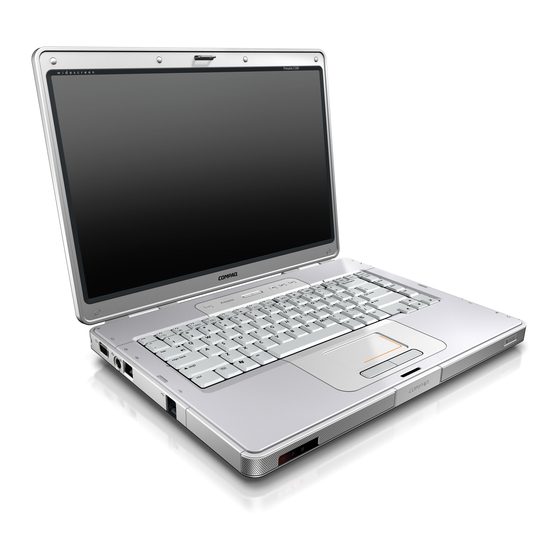
HP Compaq Presario,Presario C500 User Manual
Hp compaq presario,presario c500: supplementary guide
Hide thumbs
Also See for Compaq Presario,Presario C500:
- Maintenance and service manual (278 pages) ,
- User manual (239 pages) ,
- Hardware and software manual (223 pages)
Table of Contents
Advertisement
Advertisement
Table of Contents

Summary of Contents for HP Compaq Presario,Presario C500
- Page 1 Software Update, Backup, and Recovery User Guide...
- Page 2 Windows is a U.S. registered trademark of Microsoft Corporation. The information contained herein is subject to change without notice. The only warranties for HP products and services are set forth in the express warranty statements accompanying such products and services. Nothing herein should be construed as constituting an additional warranty.
-
Page 3: Table Of Contents
Table of contents 1 Updating software Updating the BIOS ... 2 Updating software programs and drivers ... 4 2 Recovering system information Backing up your information ... 6 When to back up ... 6 Back up suggestions ... 6 Using system restore points ... 7 When to create restore points ... - Page 4 ENWW...
-
Page 5: Updating Software
Updating software Updated versions of the software provided with your computer may be available on the HP Web site. Most software and BIOS updates on the HP Web site are packaged in compressed files called SoftPaqs. Some download packages contain a file named Readme.txt, which contains information regarding installing and troubleshooting the file. -
Page 6: Updating The Bios
Do not insert, remove, connect, or disconnect any device, cable, or cord. To download a BIOS update: Access the page on the HP Web site that provides software for your computer: Select Start > Help and Support, and then select the software and drivers update. - Page 7 BIOS installation procedures vary. Follow any instructions that are displayed on the screen after the download is complete. If no instructions are displayed, follow these steps: Open Windows Explorer by selecting Start > Computer. Double-click your hard drive designation. The hard drive designation is typically Local Disk (C:). Using the hard drive path you recorded earlier, open the folder on your hard drive that contains the update.
-
Page 8: Updating Software Programs And Drivers
Updating software programs and drivers To download and install software other than a BIOS update: Access the page on the HP Web site that provides software for your computer: Select Start > Help and Support, and then select the software and drivers update. -
Page 9: Recovering System Information
Recovering system information Tools provided by the operating system and Recovery Manager software are designed to help you with the following tasks for safeguarding your information and restoring it in case of a system failure: ● Back up your information regularly to protect your important system files. ●... -
Page 10: Backing Up Your Information
Backing up your information When to back up ● On a regularly scheduled basis. NOTE Set reminders to back up your information periodically. ● Before the computer is repaired or restored. ● Before you add or modify hardware or software. Back up suggestions ●... -
Page 11: Using System Restore Points
Using system restore points When you back up your system, you are creating a system restore point. A system restore point allows you to save and name a snapshot of your hard drive at a specific point in time. You can then recover back to that point if you want to reverse subsequent changes made to your system. -
Page 12: Creating Recovery Discs
Creating recovery discs Recovery Manager creates a set of recovery CDs or DVDs for the computer. Use recovery discs to restore the operating system and software programs to factory settings, in case of system failure or instability. NOTE Handle these discs carefully and keep them in a safe place. The software allows the creation of only one set of recovery discs. -
Page 13: Reinstalling Software Programs And Drivers
Reinstalling software programs and drivers If a program or driver preinstalled at the factory is accidentally erased or is damaged, Recovery Manager allows you to reinstall it. NOTE Software not provided with this computer must be reinstalled from the disc provided by the manufacturer or downloaded from the manufacturer's Web site. -
Page 14: Performing A Recovery
Performing a recovery Recovery Manager software allows you to repair or restore the system if you experience system failure or instability. Recovery Manager works from recovery discs that you create or from a dedicated recovery partition on the hard drive. NOTE Windows has its own built-in repair features, such as System Restore and driver roll- back capabilities. -
Page 15: Deleting The Recovery Partition On The Hard Drive
Deleting the recovery partition on the hard drive The Recovery Manager Advanced Options menu provides the option of deleting the recovery partition, which will increase space on the hard drive. Delete the recovery partition only if you have already created recovery discs. -
Page 16: Updating Reinstalled Software
Updating reinstalled software After you perform a system recovery, connect to the Internet to update all reinstalled software. To access update links for the operating system and other software provided on your computer: Select Start > Help and Support. ▲ To update optional software, follow the instructions provided by the software manufacturer. -
Page 17: Index
Index backup 6 BIOS, updating 2 drivers, reinstalling 9 recovery discs 8 recovery partition, deleting 11 recovery, system 5, 10 restore points 7 software reinstalling 9 safeguarding information 5 updating 1, 4, 12 system recovery 5, 10 system restore points 7 updates, software 1 ENWW Index...










